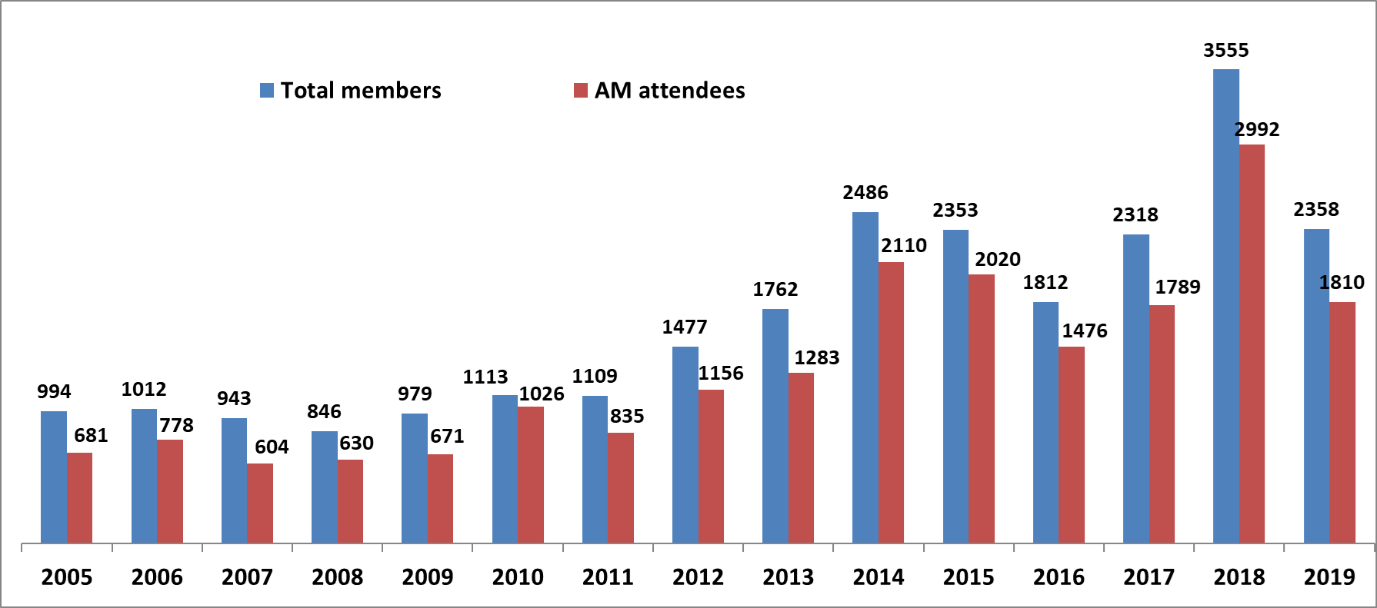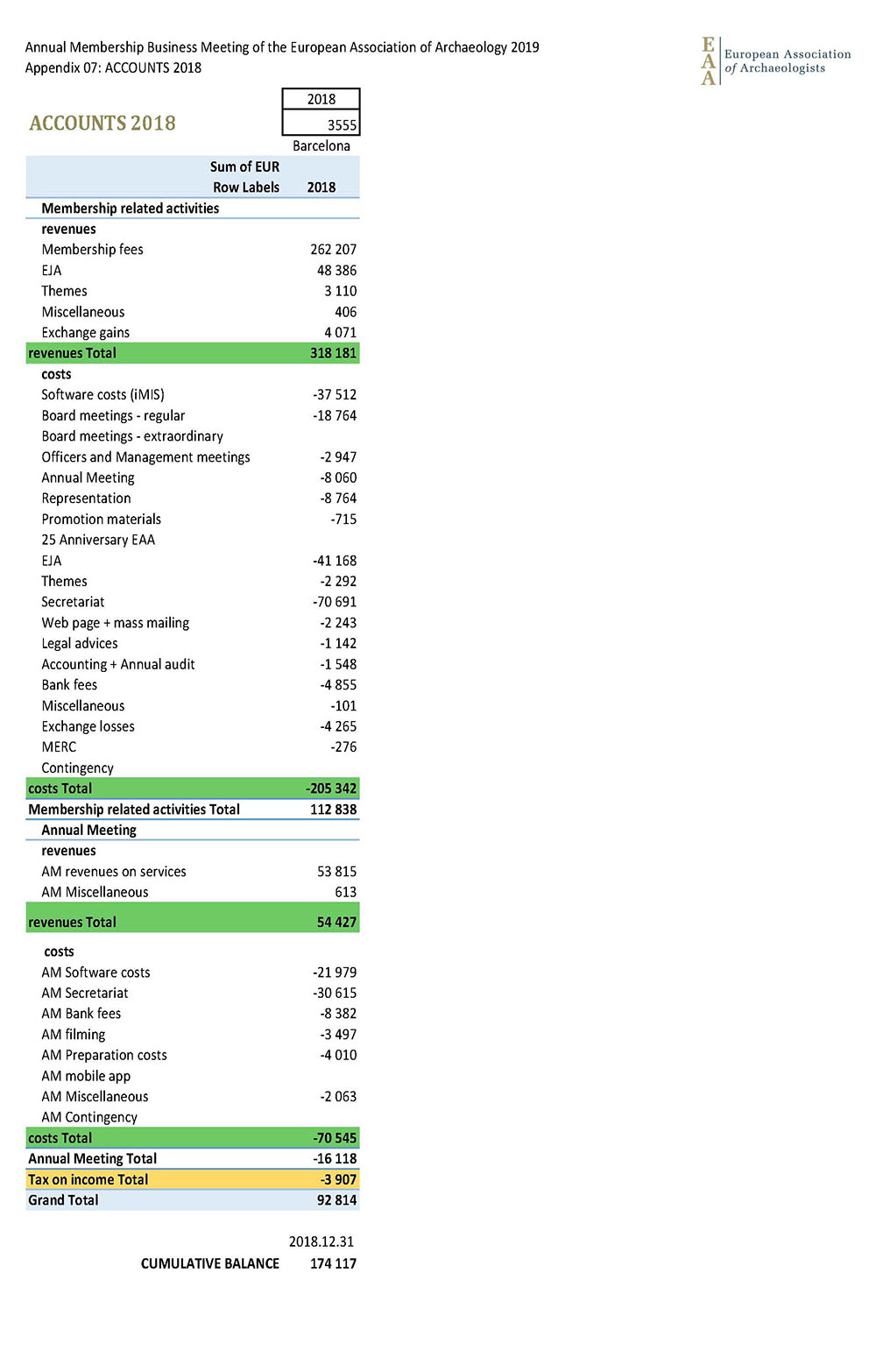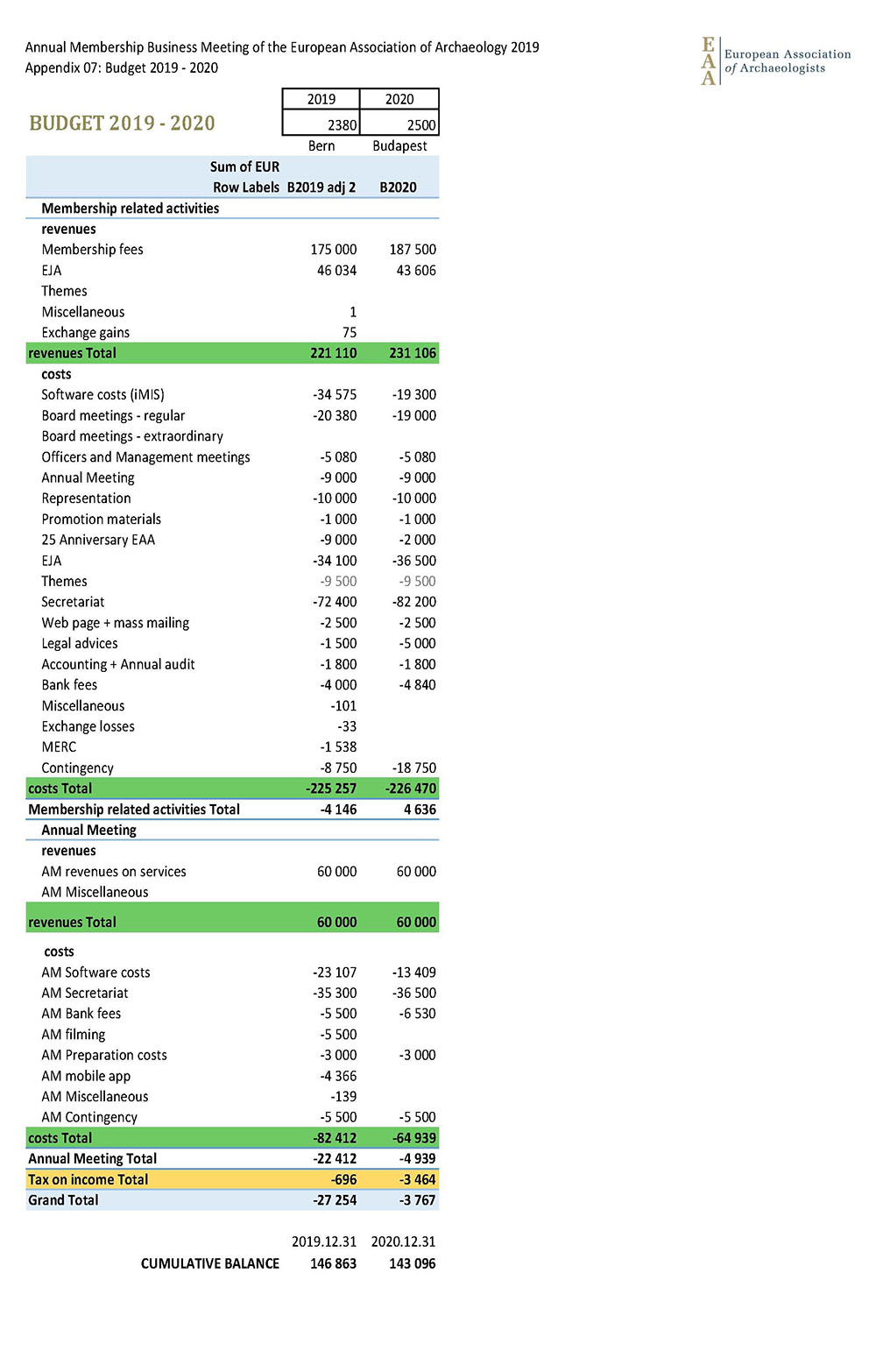Friday 6 September 2019 17:45, University of Bern, Hauptgebäude (Main Building), Room 210
Opening and welcome
The EAA President Felipe Criado-Boado opened the meeting and welcomed the 102 EAA members present. He commended the Bern organising team for a successful Annual Meeting (with a total participation of 1854 attendees, 1734 contributions and 166 sessions) and mentioned only one negative aspect – the gender imbalance at the Opening Ceremony, which does not reflect EAA policy and values but was coincidental and conditioned by the gender of the official representatives; he added that the Board will take notice of this failure and work to avoid it in the future. The President asked for applause in remembrance of Karen Waugh and Sebastiano Tusa who both passed away since the last Annual Meeting in Barcelona.
Statement issued at the 25th EAA Annual Meeting (appendix 2)
The proposed 2019 EAA Bern Statement “Archaeology and the Future of Democracy” was prepared by a task force composed of Thomas Meier (Chair), Stasa Babic, Felipe Criado-Boado, Sophie Hüglin, Jozsef Laszlovszky and Carsten Paludan-Müller, and circulated to EAA members by email in advance of the Annual Membership Business Meeting. No comments were received upon its circulation nor raised at the Meeting, and the statement was unanimously approved by members present at the Meeting. The approval of the statement is an important step forward in making the EAA socially relevant.
Minutes of the previous AMBM (circulated in TEA)
The minutes of the AMBM in Barcelona 2018 were published in the TEA and there were no comments by members. The minutes were approved unanimously as correct record of the previous AMBM.
Matters arising from the Minutes
There were no matters arising.
Strategic planning and governance
The forthcoming year marks a focus on strategic planning for future years, building on the Framework for EAA Strategic Development 2016-2021. However, any decision about the future strategic orientation of EAA must await the input of the new incoming President. Members will be informed about the progress throughout the year in TEA and emails. Some relevant points to address include:
- Updating the EAA codes of Ethics and Practice
- Putting into practice new values (new task force groups will be implemented in order to prepare this)
- Important Statutes amendments facilitate EAA internal innovations
- Campaign to recruit new corporate members
- Formal bidding process for future Annual Meetings to increase transparency and competitiveness
- Social media editor recruitment
Members are welcome to suggest further points that should be addressed in strategic planning.
Membership Report (appendices 6)
The EAA Executive Board progressed the idea of an Annual Report, presented at the 2018 AMBM by Karen Waugh – further to a trial version based on AMBM Reports, the intention is to produce an Annual Report each year for members’ reference but also to circulate to external agencies such as sponsors and for promotional purposes.
Since its foundation in 1993, the Association has experienced steady growth which has accelerated in the last five to six years (Chart 1). The increasing number of multi-annual members who do not attend the corresponding year’s Annual Meeting provides an indication of the increasing stability of EAA membership base.
 Chart 1: Number of EAA members vs. Annual Meeting participants 2005 – 2019 (as of 8 July 2019).
Chart 1: Number of EAA members vs. Annual Meeting participants 2005 – 2019 (as of 8 July 2019).
Corporate Members
The EAA President appreciated the continued support by EAA corporate members:
- Archaologie Schweiz (Switzerland)
- ASHA - Archaeological Service Agency (Albania)
- Association of Lithuanian Archaeology (Lithuania)
- AU - Institute of Archaeology of the Academy of Sciences of the Czech Republic (Czech Republic)
- HES Historic Environment Scotland (United Kingdom)
- Hungarian National Museum (Magyar Nemzeti Múzeum) (Hungary)
- Incipit - Institute of Heritage Sciences, CSIC (Spain)
- INRAP - National Institute for Preventive Archaeological Research (France)
- Institut fuer Ur- und Fruehgeschichte Kiel (Germany)
- Institute of Archaeology Russian Academy of Sciences (Russia)
- Museum of Cultural History University of Oslo (Norway)
- National Museum of Denmark (Denmark)
- NIKU - Norwegian Institute for Cultural Heritage Research (Norway)
- OCENW - Cultural Heritage Inspectorate (Netherlands)
- Prehistoric Society (United Kingdom)
- RGK - Romano-Germanic Commission DAI (Germany)
- Salisbury Régészeti Kft. (Hungary)
The EAA is working on enhancing benefits for its corporate members and to assist their engagement in the life of the Association.
The geographical bias towards membership from Western Europe and the rest of the world as compared to representation from Central and Eastern Europe continues to be considerable, but it is hoped that this may be addressed somewhat by redefinition of A and B categories.
Financial Report (appendices 7)
The text and figures of the 2018 and 2019 financial report and the budget for 2019 and 2020 were shared with members in the AMBM Reports in advance of the Meeting.
The 2018 is the first year when the EAA Secretariat completed a full annual cycle in managing some critical aspects of the EAA Annual Meetings. The 2018 Annual Meeting was very successful both academically and financially; the margin from the 2018 Annual Meeting amounting to 80 000 EUR was split between the host organisation and the EAA; following a 21% tax, a total of 27,000 EUR was donated to the Oscar Montelius Foundation and used on travel grants for the 2019 Annual Meeting participants. EAA software expenses are coming down each year following a 3-year depreciation system. The EAA’s cumulative balance in 2018 reached a comfortable level of €174,117and will be used as reserve to provide confidence for strategic planning and to cover for new EAA developments; if it continues accumulating in the coming years, part of it may be possible to consider donation to the OMF.
In 2019, the membership income is reduced due to a smaller Annual Meeting. The current Annual Meeting budget was presented for the sake of increased transparency: income on Annual Meeting registration fees is not high with respect to Annual Meeting costs, and the EAA is grateful to the local organisers and sponsors for enabling a positive budget (1/3 of the budget was supported by sponsors). The EJA continues to produce moderate profit to the EAA, but the impact of current trends towards Open Access and other transformations in the publishing sector must be taken into account in the future. EAA staffing and internal structures continue to be developed; between September 2019 and March 2020 the Administrator will be on maternity leave. Current staff will cover the Administrator’s task for that period.
This year Margaret Gowen Larsen completes her term as Treasurer. The EAA President thanked her on behalf of the EAA Executive Board and members for the excellent job she has done.
Membership fee level for 2020
The membership fee level for 2020 remains unchanged from that of 2019 (and in fact since 2017) – this was approved unanimously.


Statutes amendments (appendix 9)
No radical Statutes amendments were proposed in 2019. Those tabled are intended to adjust the EAA Statutes to cater for minor adjustments required on account of the growth and development of the Association.
Art. V / 13 – It is proposed that Corporate Members of the EAA can nominate an increased and more diversified number of individual corporate members in order to make the corporate membership more appealing to different institutions and bodies, preserving however the economic effect for the EAA:
Corporate membership shall be open to organisations and institutions that undertake to make annual financial contributions to the work of the Association. A Corporate member can nominate up to twelve of its members/employees as Full Individual Members for the year of subscription, the cost of which shall not exceed the equivalent of 10 regular full membership fees in the corresponding membership rate category.
Art. V / 13 amendment as show above was unanimously approved.
Art. VII / 1 – It is proposed that the Nomination Committee is enlarged to four instead of three members to reflect the growth of the EAA and to include early career professionals, preserving the rotation election system:
A Nomination Committee of four members shall be elected through a ballot in the normal election process. Nomination Committee Members shall serve for periods of four years, one retiring in rotation each year. No serving member of the Executive Board may be appointed to membership of the Nomination Committee. One position on the Nomination Committee shall be reserved for an early career professional.
Art. VII / 1 amendment as show above was unanimously approved.
Art. X / 8 – It is proposed to widen the scope of the EJA Advisory Board to advice and consultation regarding all EAA publications, not only the EJA; standing members of the Advisory Board agree with such scope broadening:
There shall be an EAA Advisory Board which shall, on request or at its own initiative, advise the Executive Board, the EJA Editorial Board and/or other EAA Editors or editorial boards on EAA publications and their content. The EAA Advisory Board shall consist of not less than five and not more than twelve persons suitable to advise on the EJA and its EAA publications and their content on the basis of their standing and achievement in archaeology. Subject to the preceding, the EAA Advisory Board shall be appointed by the Executive Board for a period of three years. If a person so appointed ceases to serve as a member during the three-year period, the Executive Board may appoint another to serve in her or his place for the remainder of that period. The members of the EAA Advisory Board shall elect their chairperson from among themselves.
Art. X / 8 amendment as show above was unanimously approved.
Question from the floor was raised whether the social media editor appointment will be related to the EAA Advisory Board? The social media editor status has not yet been fully defined, but it is not intended to relate it to EAA Advisory Board.
Oscar Montelius Foundation Report (appendix 10)
Eszter Bánffy, Chair of the OMF Board of Trustees, reported that the OMF held several virtual meetings of the Trustees and Auditor, and an in-person meeting with EAA Officers on 17 March in Kiel, Germany. OMF will for the time being not engage in fundraising for EAA operations and OMF endowment due to the high costs involved in a recommended feasibility study to start the process. However, depending on potential resources from EAA Annual Meetings, the OMF confirmed its intention to provide grants to the 2020 Annual Meeting participants.
The OMF will establish a prize, provisionally the Oscar Montelius Prize, to raise its visibility and to award excellence in early career achievements in archaeological work.
Eszter Bánffy steps down as OMF Trustee after having served two terms.
Nomination Committee Report and election results (appendix 11)
Bettina Arnold, Chair of the EAA Nomination Committee, informed members of the nomination and election process in 2019 and announced the election results:
Altogether 444 valid votes were received (368 on-line and 76 at the conference ballot box) and counted by the EAA Nomination Committee Members Bettina Arnold, Maria Pia Guermandi, John Robb and EAA Administrator Sylvie Květinová. The elected candidates (shown in bold below) will serve from 2019 to 2022. The EAA congratulates the successful candidates, and thanks those who were not elected for their continued interest in the work of the Association.
|
TREASURER
|
Mikkola, Esa
|
(405 received votes, 39 abstained)
|
|
EXECUTIVE BOARD MEMBER 1
|
Gomes Coelho, Rui
|
(196 received votes)
|
| |
Potrebica, Hrvoje
|
(222 received votes)
|
| |
|
6 abstained
|
|
EXECUTIVE BOARD MEMBER 2
|
Mina, Maria
|
(154 received votes)
|
| |
Pokutta, Dalia Anna
|
(137 received votes)
|
| |
Synnestvedt, Anita
|
(129 received votes)
|
| |
|
24 abstained
|
|
NOMINATION COMMITTEE MEMBER
|
Gutsmiedl-Schümann, Doris
|
(127 received votes)
|
| |
Hansen, Gitte
|
(209 received votes)
|
| |
Lazar, Catalin Alexandru
|
(84 received votes)
|
| |
|
24 abstained
|
In 2020 the EAA will elect an Incoming President and Secretary, two ExB members, and one young (emerging?) professional Nomination Committee member. Bettina Arnold stressed that EAA needs nominations and members’ engagement in order to fill these positions responsibly.
The EAA President thanked the outgoing Board and committee members and presented them with EAA gilded pin:
EAA Executive Board: Margaret Gowen Larsen, Maria Gurova
EJA Editorial Board: Robin Skeates, David Orton
OMF: Eszter Bánffy
New appointments
The EAA President welcomed newly appointed members of EAA Boards and committees:
- EJA Editorial Board
- Zena Kamash
- Marta Diaz Guardamino (re-appointed)
- Daniela Hofmann (re-appointed)
- Eileen Murphy (re-appointed)
- Joern Lang
- Clara Masriera-Esquerra
- Georg Haggren
- EAA Advisory Board
- Marinella Pasquinucci (re-appointed)
- Gustavo Politis (re-appointed)
- Robin Skeates
- Heritage Prize Committee
- Marie Louise Stig Sorensen (re-appointed)
- Nathan Schlanger (re-appointed)
- Nurcan Yalman
- Oscar Montelius Foundation
- Elin Dalen
- Adrian Olivier (re-appointed)
In light of the untimely death of the EAA Secretary Karen Waugh, the EAA Executive Board decided to co-opt Margaret Gowen Larsen as Secretary for the 2019-20 period.
EAA Publication Reports (EJA, Themes, Elements, TEA; appendices 13)
Catherine Frieman has worked with Robin Skeates as EJA Editor for the past 3 years and thanked him for his support and mentorship. Zena Kamash, the newly appointed Deputy Editor, and the three new EJA Editorial Board members will bolster the team to continue producing a high ranking Journal.
The EJA Code of Ethics was approved and published to promote ethical publishing practice incl. double-blind peer-review to increase equality. Open Access impact on EJA is difficult to assess at present, and the Editors will continue to monitor all options to ensure a sustainable EJA in a new publishing context. Discussion was raised within the Editorial Board about an alternative on-line only EJA and the question will be included in the EAA members’ survey. EJA invites new submissions, especially discussion pieces.
Eszter Bánffy, one of the three THEMES in Contemporary Archaeology monograph series editors, reported that THEMES has as of August 2019 published six volumes with Maney Publishing and Routledge, and five more volumes are currently in various stages of preparation. The monographs are in process of identifying a new publisher.
Katharina Rebay-Salisbury, one of the two editors of The European Archaeologist (TEA) newsletter, asked members for submissions especially into the debate section and encouraged EAA communities to report on their activities – the next deadline is 15 October. TEA editors are looking for ideas for a new end page theme for TEA (in the past, members have contributed to “Where archaeology is made” (your offices and workspaces), “Archaeocakes”, and this year photos from “25 Years of EAA”).
Elements: Archaeology of Europe, edited by Bettina Arnold and Manuel Fernández-Götz, experienced some initial administrative delays, but five proposals for volumes have already been submitted and at least eight more are expected by the end of this year.
EAA Communities (appendix 14)
Sophie Hüglin stated that all EAA communities are active incl. the new communities (COMFORT, Disco). EAA communities Assembly was held on Wednesday 4 September, and further fostering of communication between EAA communities and members will be sought.
Location of future Annual Meetings
- 26th 2020 Budapest, Hungary
- 27th 2021 Kiel, Germany
- 28th 2022 Belfast, Northern Ireland
Among the planned but not yet approved venues are:
- 29th 2023 Brussels, Belgium
- 30th 2024 Braga, Portugal
New Annual Meeting locations beyond 2024 are to be approved after a new incoming President is elected.
Announcement of the 26th EAA Annual Meeting
Alexandra Anders, David Bartus, Szilvia Fábián and Eszter Kreiter invited all members to Budapest 2020 26th EAA Annual Meeting.
The Annual Meeting themes, as defined by the Scientific Committee, incorporate the diversity of EAA and the multidimensionality of archaeological practice, including archaeological interpretation, heritage management and politics of the past and present.
- Networks, networking, communication: archaeology of interactions
- From Limes to regions: archaeology of borders, connections and roads
- Sustainable archaeology and heritage in an unsustainable world
- Waterscapes: archaeology and heritage of fresh waters
- Theories and methods in archaeology: interactions between disciplines
- Embedded in European archaeology: the Carpathian Basin
- 25 years after: The changing world and EAA's impact since the Santiago 1995 EAA Annual Meeting
The motto of the 2020 Annual Meeting in Budapest is “Networking!”. It was chosen because Budapest, at the centre of Hungary and the Pannonian Basin has always been a continuous interface between different networks and networking systems in the past, and networking is a prominent feature of today’s society as well. The 26th EAA Annual Meeting web page is available at www.e-a-a.org/EAA2020. The call for sessions will open in end September, and registration will start in mid-October.
25th Anniversary of EAA foundation
Founded in 1994 at the Inaugural Meeting in Ljubljana, the European Association of Archaeologists is proud to celebrate its 25 years’ anniversary. Enamel pins were given to members in delegate bags to celebrate the past and promote the future of the Association, and gilded pins were distributed to those who were presenters at the Inaugural Meeting 1994 and other distinguished members of the EAA during a toast with them at the Annual Party. The anniversary postcards were available to members at the EAA desk and the AMBM, and other promotion materials and publications are under preparation.
Any Other Business
Since there was no other business, the EAA President closed the meeting.
Go back to top